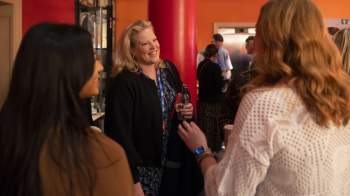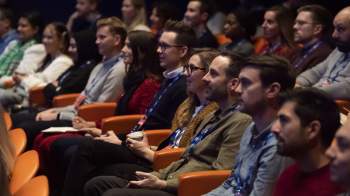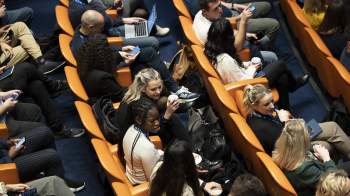“We are moving from commerce to engagement”
IAB UK
The IAB UK’s Data and Innovation conference at The British Museum on 15 March provided a whistle-stop tour of some of the seismic changes occurring in the digital marketing landscape today.
First up was AKQA’s Michael Andrews, who outlined how we are moving into the age of artificial intelligence (AI) with self-driving cars, personal AI assistants, delivery drones and emotion-sensing robots. He discussed the challenges and opportunities for brands as they adapt to this new reality.
“Things that have so far been behind the scenes are starting to become consumer facing,” he said – pointing by way of example to fully robotic restaurants in San Francisco, and interactive billboards with gender-detection software.
“We are moving from commerce to engagement,” he continued –pointing out that the exponential increase in computing power, the rise of the cloud and increasing data transmission speeds mean that everything now has the potential to become an interface.
“It will be the job of the CMO to manage the AI,” he predicted, urging the audience to consider how their brand AI could be brought to life across channels. “It’s all about continuous engagement with customers,” he added.
Next up was Kantar Media’s Emma Hargreaves, who delivered another thought-provoking session which focused on how marketers can make digital spend work harder.
She highlighted two key ways in which this can be achieved: by gaining a joined-up and optimised approach to online consumer targeting; and by ensuring that programmatic campaigns are as transparent as possible. “That means targeting audiences programmatically based on data that is built on granular offline consumer activity, as well as online, to ensure wastage is minimised and spend optimised,” she said.
And, whilst admitting that many are still ‘drowning’ in data, she concluded with an upbeat message: “The tech and the data is there … it’s not an insurmountable challenge,” she said.
Jon Schulz, CMO, Viant then spoke about the rise of ‘people based’ marketing – a recurrent theme of the day: Time and time again the audience was told that UK digital marketers are turning away from cookie-based campaigns.
Next up, MBNA’s Nic Travis stressed the importance of what he called ‘incrementality’: He urged the industry to move on from ‘outdated’ click-based measurement techniques, but he admitted, too that cross-device tracking ‘is not easy’.
And Vihan Sharma of LiveRamp once again warned that the omnichannel environment has created challenges when it comes to targeting. But he believes that achieving a ‘unified’ approach is possible and he gave the example of cosmetics company, Sephora, which he said had optimised its retargeting budget by about 30% with LiveRamp’s help ‘onboarding’ CRM insights.
Rubicon Project’s James Brown and Marco Bertozzi, VP Europe at Spotify, then discussed the importance of using data in a way that is ‘cool, not creepy’.
Bertozzi said that, while audio advertising represents ‘a big opportunity’, headphones make for a particularly ‘intimate’ experience. As such, he said it’s vital to ensure data is used in a way which is ‘smart, not clumsy’.
The ensuing panel discussion again explored this need for trust, transparency, and respect - with marketers from the likes of Yahoo, the FT and Auto Trader pointing in particular to the need to avoid ‘interruptive’ advertising formats on mobile devices.
Index Exchange’s Luke Fenney then urged buyers to “start talking to publishers” and to ensure the industry comes up with a model that works when it comes to the increasingly popular practice of header bidding.
Next, Steve Latham, Head of Analytics at Flashtalking and Robert Foulkes, Monarch Airlines’ Head of Marketing and Digital, described their success in using data-driven insights to drive down customer acquisition costs for the airline.
“How you give credit where it’s due has become a bigger challenge,” warned Latham, who claimed that ‘algorithmic fractional attribution’ is ‘the new standard’. It enables marketers to more accurately assess the contribution of each touchpoint, he said.
Foulkes explained that it can provide a ‘normalised’ view of each channel’s contribution, adding that the approach had given Monarch more confidence in its media-buying.
Joanna Pawluk, Chief Growth Officer at indaHash also outlined how a programmatic approach to influencer marketing is possible today.
She gave the example of a campaign by cookery brand Schwartz which used UGC to fuel digital Out-of-Home (OOH) at Picadilly Circus in central London - and which reached nearly a million people via 30 influencers
Next, Jim Hodgkins, MD, and Anastasia Petri, Account Manager, at VisualDNA - part of Nielsen Marketing Cloud - urged marketers to consider personality traits when targeting campaigns – predicting that ‘the next generation’ of targeting will take on board ‘how people’s minds work’.
Ruth Zöhrer, Head of Programmatic Marketing at Mindshare UK and Michel Debiol, Agency Group Head at Xaxis, then outlined how they delivered an integrated campaign for Volvo which leveraged data in innovative ways at every stage.
Finally, during the last session of the day, Ben Maher, Sales and Partnerships Director at JCDecaux spoke about the opportunities inherent in mobile OOH.
In a passionate plea for the industry to work together to drive ‘mass personalisation’ of OOH, Maher said: “Automation is where we are headed. We need to work together. We need to break down silos.”
Related content
IAB UK’s question about cookie consent debated in House of Lords
Learn moreNew data Bill drops plans for centralised cookie consent
Learn moreRetail media spend to surpass £1bn in the UK in 2025
Learn moreEU Commission adopts data adequacy decision for the UK
Learn more
Fast forward to 2030 with Futurescape
An in-depth exploration of the attitudes, innovations and media shifts that will shape the years ahead and redefine how we advertise by the turn of the decade



